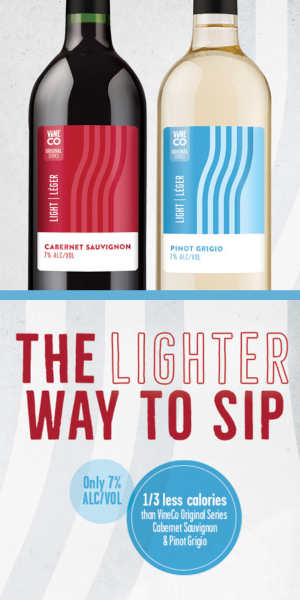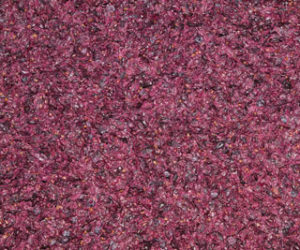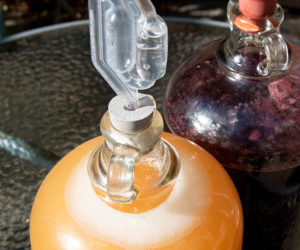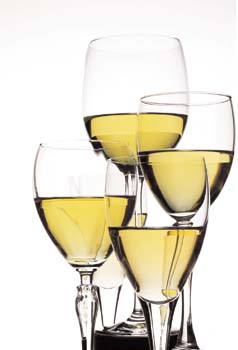 The sensory profile of a wine is its calling card, its résumé and its history. The quality of a wine, and its ability to leave a lasting imprint in our memory, is the task of every winemaker and the joy of every wine drinker. With their personal experience and knowledge, winemakers will work with this raw material — the freshly harvested grapes — and try to release the full potential. Many techniques are used to accomplish this task, and one of the most powerful tools is the use of wine yeasts, carefully screened and isolated from its environment. A case study on Chardonnay reveals the impact that different yeast strains have in different grape growing regions.
The sensory profile of a wine is its calling card, its résumé and its history. The quality of a wine, and its ability to leave a lasting imprint in our memory, is the task of every winemaker and the joy of every wine drinker. With their personal experience and knowledge, winemakers will work with this raw material — the freshly harvested grapes — and try to release the full potential. Many techniques are used to accomplish this task, and one of the most powerful tools is the use of wine yeasts, carefully screened and isolated from its environment. A case study on Chardonnay reveals the impact that different yeast strains have in different grape growing regions.
Wine sensory properties come essentially from the grape itself and where and how it was grown. They will vary according to the different treatments the wine received during fermentation, as well as during the aging process. The grape varietal precursors serve as a source of elements that will be used by the yeast in order to be transformed into aroma compounds that are perceived by the human nose.
Yeasts differ in their potential accomplishments and each strain of yeast has unique and particular abilities to transform one precursor into one aromatic compound. Now imagine that yeasts, in all their complexity, vary in the aroma compounds they produce. The sensory properties of the wine will therefore be different.
In order to study the potential of wine yeast strains, Lallemand conducted a study on the behavior of different Saccharomyces cerevisiae strains in making Chardonnay.
The goal of the study was to see how those different yeasts — selected from different wine regions — would influence the sensory profiles of those wines. Would they make uniform and undifferentiated wines within the trials? Or would they rise up to the challenge and really use the different varietal precursors, which would be more or less present depending on the region, and give a unique quality wine.
The Grape
Chardonnay is one of the Vitis vinifera varieties of wine grapes. Sometimes called the king of the white wine varieties, it’s one of the most popular grapes with both commercial and home winemakers. It is grown in France and is the primary white varietal grown in Burgundy, where it is made into Chablis. It is also one of the primary grape varieties found in Champagne. Chardonnay is also grown in Italy, California and in many other locations.
For home winemakers, there are plenty of kits on the market and juice is also readily available. Winemakers in grape-growing regions will likely also be able to find grapes around harvest time. The best grapes are in the 23–25 °Brix range and register 6.0–8.0 g/L of titratable acidity.
Chardonnay wines range from big, buttery examples to crisper, more “steely” types. In the bigger, more complex Chardonnays, winemakers almost always encourage a malolactic fermentation (MLF) and age the wine in oak. One consequence of malolactic fermentationis that it yields a buttery note that blends with the oak. In the lighter style, an MLF is usually prevented and the wine is aged in stainless steel.
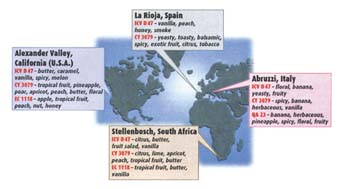
The Study
We set up worldwide winery trials using high-quality Chardonnay grapes from different wine regions of the world: Alexander Valley, California; Abruzzi, Italy; Stellenbosch, South Africa and La Rioja, Spain. We also selected different yeasts commonly used in those regions.
At that time, we mostly had anecdotal information on the performance of each yeast strain, in terms of sensory contribution to the wines, but nothing concrete and scientific. One of the most interesting parts of this study was to solicit the help of winemakers and wine experts from each specific region where the wines were elaborated. During each tasting, the sensory panel consisted of the experts from that particular region, who, in our evaluation, represent the best panel we could have since they know their particular styles inside out. The methodology of the evaluation called for is “free-choice profiling” and with this method we were able to hold the tastings locally.
The Results
The first tasting was held in South Africa in the region of Stellenbosch. A winery trial was set up with three different yeast strains, and 12 winemakers were present during the tasting. The 1996 Chardonnay was then nine months old and had gone through traditional winemaking processes, but with no barrel aging or malolactic fermentation.
The results from this tasting are very interesting. The yeast strain CY 3079, selected in Burgundy, produced a very fruity Chardonnay. On the other hand, ICV D47, another French isolate, resulted in greater complexity with both fruity and buttery aromas so typical of this type of wine. As for the EC 1118, a Champagne isolate used in different varietals, it was defined with a mixture of tropical fruit, vanilla and butter. All three wines were clearly different from one another.
A similar trial was also held in the renowned Alexander Valley in California, again in a winery, with Chardonnay fermented by three different yeast strains. In this case, CY3079 showed some definite fruity trends, as it did in South Africa, but with more stone fruits such as peach and apricot and no citrus aromas. The ICV D47 also showed those buttery, caramel notes. But instead of citrus aromas such as those found in South Africa, it showed more spicy notes. The third sample, fermented with EC 1118, was a nice mixture of nutty, fruity and honey notes. In the Abruzzi region of Italy, with its Mediterranean climate, large-scale Chardonnay fermentations were carried out with three different yeasts. The results here differed from the South African and American wines. The wines fermented with CY3079 were fruity and spicy, with vanilla and herbal notes. The ICV D47 wines were fruity and floral, compared to the QA23, which were predominanted by tropical fruits and spices. Our final tasting was held in the La Rioja region of Spain, where the climate is a mixture of Atlantic and Mediterranean conditions, and where the white wines are usually aromatic. The large-scale winemaking was carried out with the ICV D47 and CY3079 yeast strains. We found that the ICV D47 wines were represented by vanilla and honey aromas, as well as peach. On the other hand, the CY3079 brought out the more toasty and spicy notes. This is in complete opposition with the more fruity styles that came out in the Italian wines.
Conclusion
Chardonnay is one of the most frequently planted varietals in the world. It can be found made in several styles: fresh fruit forward, barrel fermented or aged, malolactic or not, blended or not, sparkling or still. The choices are numerous and the styles vary from country to country, from region to region, and even from winery to winery. In that context, it was imperative to understand the type of sensory characteristic the Chardonnay would exhibit when fermented by premium yeast strains selected from nature.
From the sensory profile of each wine from the different wine regions, we can see that all yeast strains, within the same winery, gave different sensory profiles. From one country to another, we could sometimes see trends (e.g., a fruitier style in South Africa and the United States with CY3079), but overall the sensory profile of each wine is unique, when evaluated by winemakers specialized in Chardonnay and confirmed by the scientific sensory method. We must keep in mind that the foremost criteria for defining a wine is the quality of the grape. The yeast that the winemaker uses is a natural tool to enhance the must precursors, and each precursor profile is unique to the regional viticulture. We can see that the yeast strains will have specific tendencies due to their particular ability to work in a specific must. For example, some strains will enhance fruitier aromas, whereas others will bring out more toasty, vanilla-like aromas. Winemakers have the ability to add the final touch through blending the fermented wines and obtaining their signature wine.

